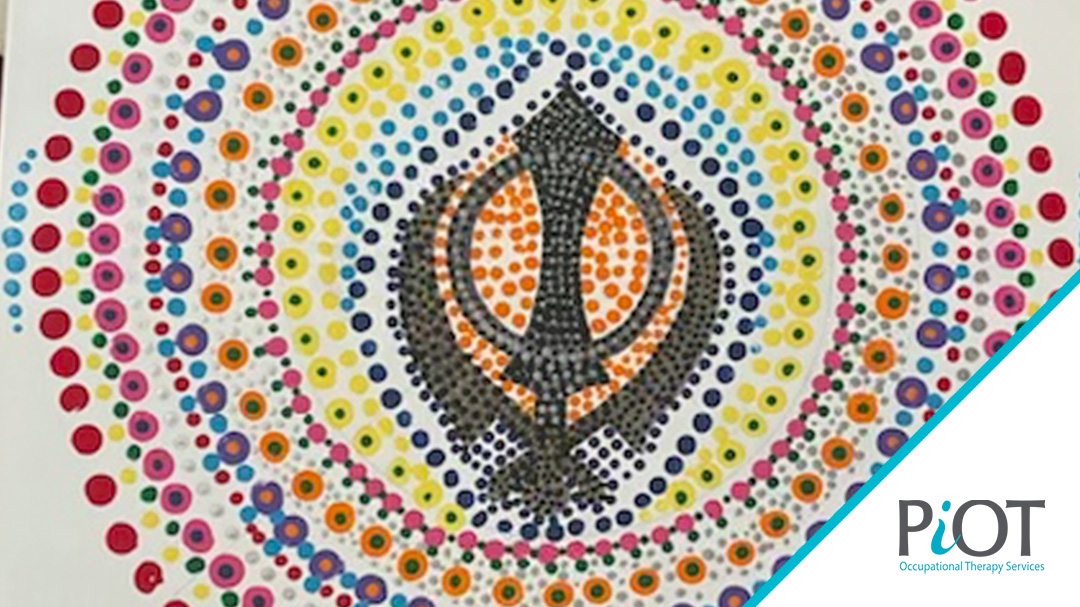
23 May Channelling your Inner Artist for Recovery
Inside every one of us, there is a creative genius. In some of us, this gift is hidden, or at best, underused. Through lifestyle, vocation or lack of opportunity, sometimes this inner talent is not expressed to its full potential. As an experienced occupational therapist, in my sessions I have seen the therapeutic power of creating artwork to help people of all ages overcome a wide range of physical, emotional, cognitive, and mental health challenges.
Case Study
CHALLENGE
A 65 year old female client who had sustained a moderate brain injury in a severe motor vehicle accident was not motivated to her pre-accident activities such as meal preparation, household activities, or socializing with family and friends after the injury. She had difficulty with memory, concentration, planning, and initiating tasks. She was noted to only be able to do one to two steps at a time and required cueing and assistance for most daily activities. The goal of treatment was to help her find a sense of purpose, joy, and quality of life in her day to day activities while working on improving her cognitive skills.
SOLUTION
The client was introduced to a painting activity, dot art, to paint mandalas. This activity involved painting on a large canvas using different coloured paints and dowels of various sizes. The activity was graded to her cognitive level. The steps involved selecting a size of the dowel, a colour of paint, and a simple pattern to paint each ring around the circle. With each circle, she would come back to the same choices. To make the art project even more unique and meaningful for her, we outlined the Sikh religious symbol representing her religion in the center. She was astonished at what she could create despite her impairments and was most engaged in this project.
RESULTS
The activity helped her to practice multiple cognitive skills, such as setting a simple goals of planning, concentration, memory, evaluating, and mental flexibility. Her goal was to complete the painting and hang it up in her living room. She set up a plan for each circle once she made the decision about the colour and pattern she was going to use. She practiced using her working memory by remembering the rules and what she was doing for each circle. She practiced sustaining her attention by focusing only on one simple pattern at a time as she did each circle of the mandala. The fact that it was not a serious decision to make made it less stressful for her to participate in the decision-making process. After a few sessions she was hooked, and she expressed that she enjoyed the process of choosing the colour and design for each circle. At the end of each session, she looked at the painting from a distance and evaluated what she had created and decided if she liked it or not, and what she would do differently. As the sessions progressed, she became more confident and was set up and ready to start painting when I arrived. The painting activity being fun and not serious, created a sense of ease during the sessions which resulted in her laughing and talking more than ever before.
CONCLUSIONS
Here are some of the key benefits of art therapy:
- Stress relief: Art therapy provides a creative outlet that can help individuals relax and reduce stress. The act of creating art can be meditative and calming, allowing individuals to focus their minds and release tension.
- Emotional expression: Painting or creating art can be a powerful tool for expressing emotions that may be difficult to put into words. Through the use of color, shape, and texture, individuals can communicate their feelings and experiences in a way that is both visual and tangible.
- Increased self-awareness: Creating art can help individuals gain insight into their own thoughts, emotions, and behaviors. By exploring their own creative process, individuals can better understand themselves and their relationship to the world around them.
- Improved fine motor skills: Painting and other forms of art require the use of fine motor skills, such as hand-eye coordination and finger dexterity. Regular practice of these skills through art therapy can lead to improved coordination, strength, and flexibility.
- Cognitive stimulation: Engaging in art therapy can help individuals exercise their brains and improve cognitive function. Creating art requires problem-solving skills, critical thinking, and attention to detail, all of which can be beneficial for brain health.
- Increased self-esteem: Creating art can be a confidence-building activity, as individuals are able to see the tangible results of their efforts. Completing a piece of art can provide a sense of accomplishment and boost self-esteem.
- Socialization: Art therapy can also be a social activity, providing individuals with opportunities to connect with others who share their interests. Group art therapy sessions can foster a sense of community and support.
Overall, painting and creating artwork can be a valuable therapeutic activity for individuals looking to improve their physical, cognitive, and mental health. As an occupational therapist, I highly recommend exploring the benefits of art in occupational therapy practice and incorporating it into a comprehensive treatment plan.

